Medals
Medals and honour badges from the 19th and the 20th centuries.
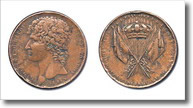
Distribution of flags to provincial legions (1809)
Legions of provincial guards (decree of May 15th 1806) were one of the first tangible signs of king Giuseppe Bonaparte's will to give a more substantial freedom to the provinces of the kingdom. The troops, consisting of representatives of the local middle class, were appointed to protect people, defend property rights and look after public order.
Having ascended the throne of Naples a few months earlier, Gioacchino Murat, in November 1808, arranged the reordering of the provincial legions and on March 26th 1809 attended, together with his wife Carolina Bonaparte, the flag awarding ceremony.
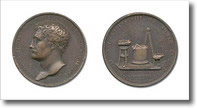
Gian Lorenzo Bernini (1832)
The medal dedicated to Bernini, (1598-1680), architect, sculptor, painter, scenery-painter and theatrical author, is part of a series from the Mint of Naples between 1830 and 1834.
The idea of coinage was thanks to Lorenzo Taglioni (Neapolitan citizen, button manufacturer), who decided to dedicate 120 medals to as many distinguished men, born in the Kingdom of the Two Sicilies; only 17 medals have so far been coined.
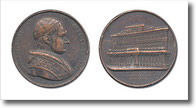
Pope Gregory XVI, annual medal (1838)
Medal denominated annual for being part of an official coinage the Vatican used to be issued in memory of the year of pontificate of every pope. It refers to the eighth year from the election of Gregory XVI (in the world, Bartolomeo Alberto Cappellari, pont. 1831-1846).
The reverse side of the medal shows the Saint Michael Hospice Building in Piazza Colonna (Wedekind Building since 1872). This palazzo was the residence of the Papal Posts and since 1871 one floor lodged the Ministry of Public Instruction of the newly founded Kingdom of Italy. Today it is the headquarters of the newspaper Il Tempo.
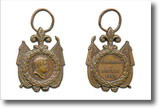
To the army and navy officers who took part in the Campaign of Sicily in 1848 (1849)
On August 30th 1848, aiming to suppress the revolt that broke out in Sicily months earlier, a few ships sailed from the gulf of Naples to carry the troops sent to restore order on the island. The command of the operations was given to General Carlo Filangieri and on September 6th order was already restored. During the months following these first military successes, Filangieri tried to find a diplomatic solution to avoid further bloodshed but his attempt proved unsuccessful and the military action went on.
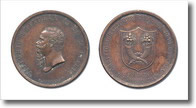
Foundation of the agrarian campaign in the surroundings of Caserta (1862)
Anticipating by about four years the issuing of the royal decree setting up an agrarian campaign in every chief town of the kingdom (Royal Decree of December 23rd 1866, followed by the regulation of February 18th 1867), on May 1st 1862 there was the foundation of an agrarian campaign in the Province of Terra di Lavoro.
From the start, it already numbered three hundred members and only five months after its establishment it managed to organize an exhibition of products, manufactured goods and rural equipment. This was the first event of its kind in Italy.
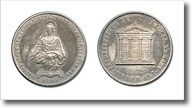
Saint Lucia proclaimed joint patron saint of Naples
In 1904, during the sixteenth centenary of the death of the saint (281-304), Pope Pius X accepted the requests of the Neapolitan believers: with a decree dated January 13th 1904, the Holy Rites Congregation proclaimed the martyr joint patron saint of the archdiocese of Naples.
The alms collected helped to have a silver bust of the saint made, realized by Vincenzo Catello and based on a drawing by Salvatore Cepparulo, teacher at the Arts and Industrial Museum.
Area Cultura e Turismo Servizio Beni Culturali - Archivio Storico Municipale
Salita Pontenuovo, 31 - 80139 Napoli
e-mail: archivi.storici.biblioteche@comune.napoli.it
pec: archivi.biblioteche@pec.comune.napoli.it
 check the complete file-card of the medal and its high resolution image
check the complete file-card of the medal and its high resolution image